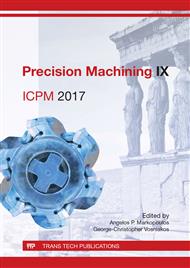[1]
J.C. Chen, M. Savage, A Fuzzy-Net-Based Multilevel In-process Surface Roughness Recognition System in Milling Operations, The International Journal of Advanced Manufacturing Technology 17 (2001) 670-676.
DOI: 10.1007/s001700170132
Google Scholar
[2]
G. Quintana, M. L., Garcia-Romeu, J. Ciurana, Surface roughness monitoring application based on artificial neural networks for ball-end milling operations, Journal of Intelligent Manufacturing 22 (2009) 607–617.
DOI: 10.1007/s10845-009-0323-5
Google Scholar
[3]
Sivarao, Castillo, Taufik, Machining Quality Predictions: Comparative Analysis of Neural Network and Fuzzy Logic, International Journal of Electrical & Computer Sciences IJECS 9 (2000) 451-456.
Google Scholar
[4]
Á. Drégelyi-Kiss, R. Horváth, B. Mikó, Design of experiments (DOE) in investigation of cutting technologies, Development in Machining Technology DIM, Cracow (2013) 20-34.
Google Scholar
[5]
I. Maňková, M. Vrabeľ, J. Beňo, P. Kovač, M. Gostimirovic, Application of Taguchi method and surface response methodology to evaluate of mathematical models for chip deformation when drilling with coated and uncoated twist drills, Manufacturing Technology 13(4) (2013).
DOI: 10.21062/ujep/x.2013/a/1213-2489/mt/13/4/492
Google Scholar
[6]
Y. Hadi, S.G. Ahmed, Assessment of Surface Roughness Model for Turning Process. Knowledge Enterprise: Intelligent Strategies In Product Design, Manufacturing, and Management, in International Federation for Information Processing (IFIP) 207 (2006).
DOI: 10.1007/0-387-34403-9_19
Google Scholar
[7]
C.C. Chen, K.T. Chiang, C.C. Chou, Y.C. Liao, The use of D-optimal design for modeling and analyzing the vibration and surface roughness in the precision turning with a diamond cutting tool, International Journal of Advanced Manufacturing Technology 54 (2011).
DOI: 10.1007/s00170-010-2964-0
Google Scholar
[8]
A. Choudhary, J. Harding, M. Tiwari, Data mining in manufacturing: A review based on the kind of knowledge, Journal of Intelligent Manufacturing 20(5) (2009) 501-521.
DOI: 10.1007/s10845-008-0145-x
Google Scholar
[9]
M. Grzenda, A. Bustillo, P. Zawistowski, A soft computing system using intelligent imputation strategies for roughness prediction in deep drilling, Journal of Intelligent Manufacturing 23 (2012) 1733-1743.
DOI: 10.1007/s10845-010-0478-0
Google Scholar
[10]
J. Balic, M. Korosec, Intelligent tool path generation for milling of free surfaces using neural networks, International Journal of Machine Tools & Manufacture 42 . (2002) 1171-1179.
DOI: 10.1016/s0890-6955(02)00045-7
Google Scholar
[11]
C.J.L. Pe´rez, Surface roughness modeling considering uncertainty in measurements, International Journal of Production Research, 40(10) (2002) 2245-2268.
DOI: 10.1080/00207540210125489
Google Scholar
[12]
R. Azouzi, M. Gullot, On-line prediction of surface finish and dimensional deviation in turning using neural network based sensor fusion, International Journal of Machine Tools and Manufacturing 37(9) (1997), p.1201–1217.
DOI: 10.1016/s0890-6955(97)00013-8
Google Scholar
[13]
S.Y. Ho, K.C. Lee, S.S. Chen, S.J. Ho, Accurate modeling and prediction of surface roughness by computer vision in turning operations using an adaptive neuro-fuzzy inference system, International Journal of Machine Tools and Manufacture 42(13) (2002).
DOI: 10.1016/s0890-6955(02)00078-0
Google Scholar
[14]
W. Zębala, J. Gawlik, A. Matras, G. Struzikiewicz, Ł. Ślusarczyk, Research of surface finish during titanium alloy turning, Key Engineering Materials 581 (2014) 409-414.
DOI: 10.4028/www.scientific.net/kem.581.409
Google Scholar
[15]
T. Rajasekaran, K. Palanikumar, B.K. Vinayagam, Application of fuzzy logic for modeling surface roughness in turning CFRP composites using CBN tool, Production Process 5(2) (2011) 191-199.
DOI: 10.1007/s11740-011-0297-y
Google Scholar
[16]
B. Savković, P. Kovač, K. Gerić, M. Sekulić, K. Rokosz, Application of neural network for determination of cutting force changes versus instantaneous angle in face milling, Journal of Production Engineering 16(2) (2013) 25-28.
Google Scholar
[17]
J. Kundrák, G. Varga, Use of Coolants and Lubricants in Hard Machining, Technical Gazette 20(6) (2013) 1081-1086.
Google Scholar
[18]
P. Kovac, D. Rodic, V. Pucovsky, B. Savkovic, M. Gostimirovic, Application of fuzzy logic and regression analysis for modeling surface roughness in face milling, Journal of Intelligent Manufacturing 24(4) (2013) 755-762.
DOI: 10.1007/s10845-012-0623-z
Google Scholar
[19]
J.S.R. Jang, C.T. Sun, Neuro-Fuzzy Modeling and Control, Proceedings of the IEEE 83 (1995) 378-406.
Google Scholar
[20]
L. C. Ying, M. C. Pan, Using adaptive network based fuzzy inference system to forecast regional electricity loads. Energy Conversation and Management 49 (2008) 205-211.
DOI: 10.1016/j.enconman.2007.06.015
Google Scholar
[21]
E. Avci, Comparison of wavelet families for texture classification by using wavelet packet entropy adaptive network based fuzzy inference system. Applied Soft Computing 8 (2008) 225-231.
DOI: 10.1016/j.asoc.2007.01.003
Google Scholar


